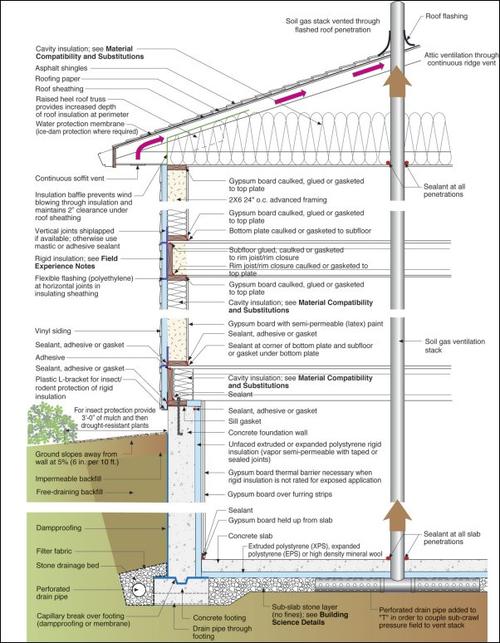This two-story enclosure with a basement is designed for Chicago, IL (Cold Climate). It features a vented attic with a raised heel truss and cavity insulation at the attic floor, and asphalt shingles. The 2x6 advanced wood frame walls are insulated with cavity insulation and rigid insulation on the exterior, and feature vinyl siding. The rim joist is insulated with cavity insulation on the interior. The foundation wall is insulated with unfaced XPS or EPS rigid insulation on the interior. XPS/EPS/high density mineral wool insulation is installed under the foundation slab.
Enclosure Design
Construction Recommendations
- Foundation: Basement
- Above Grade Walls: Wood frame
- Cladding: Vinyl siding
- Attic: Unconditioned
- Roof: Asphalt shingles
Building Science Notes
- Ducts in conditioned space - This building profile is designed to accommodate HVAC equipment and ducts in the basement and living space, not in an unconditioned attic. HVAC ducts should not be run in exterior walls.
- Air sealing details at transitions– Air sealing can be particularly difficult, but no less important, at assembly transitions such as band joists, and between attached garages and living spaces. These are discussed below because they have proven to be a consistent challenge for builders.
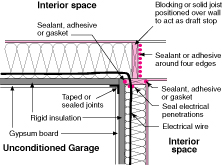
Figure 1- Band joists – Continuity of an exterior air barrier can be maintained at the band joist with sealed or taped housewrap or rigid foam insulation. Continuity of an interior air barrier can be maintained through a combination of cut foam blocks and sealant/caulk, rigid draftstopping material (wood blocking) and sealant/caulk, or spray foam. Note that neither cellulose nor fiberglass (batt or blown) can be used for the air barrier. The air barrier detail on second-story band joists is important because it is inaccessible (covered by structural/finish floor and ceiling finish) after construction. Note that while fiberglass batts fulfill the requirement for protection from ignition in the open band joists, fiberglass batt material by itself cannot maintain the air barrier.
- Attached garages – the building enclosure surfaces shared between conditioned space and an unconditioned garage must have a continuous air barrier. See Figure 1 for details in terms of using sealants and rigid insulation to create a continuous air barrier between the attached garage and living space. See Air Sealing / Air Drywall Approach Details.
- Drying mechanisms – In any climate, vapor control is based on the relationships among the following: the permeability of wall components, the type of cladding (reservoir or non-reservoir), the presence/lack/nature of an air space, and the magnitude/duration of the vapor drive (based on the relationship between the exterior and interior moisture content and temperature differences). The type of sheathing and housewrap used in any wall assembly must be based on an understanding of these inter-relationships. See “Insulations, Sheathings, and Vapor Diffusion Retarders” for more information.
In cold climates, the moisture load in the winter months is primarily from the interior, so roof and wall assemblies are generally designed to dry primarily to the exterior. Wintertime condensation control can be facilitated by elevating the temperature of the first condensing surface (the back side of the exterior sheathing) via the use of insulating sheathing. When XPS (with relatively low permeability) is used, then only slow drying is available to the exterior. Accordingly, the majority of drying occurs to the interior during the summer months. Therefore, interior vapor barriers should not be installed. Note that there is a difference between an interior vapor barrier and an interior vapor retarder (see “Insulations, Sheathings, and Vapor Diffusion Retarders”). Particular care must be taken to prevent the entry of bulk water (i.e. leaks) and to control interior relative humidity in the coldest months. See Material Compatibility and Substitutions.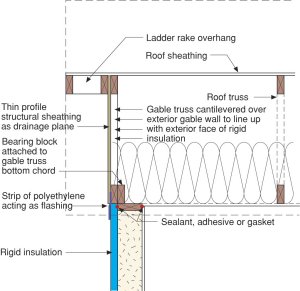
Figure 1a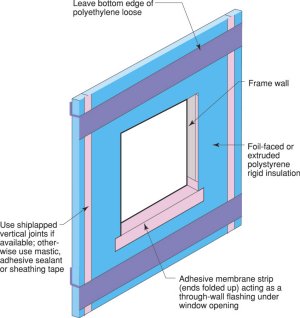
Figure 2 - Drainage plane, air barrier, vapor control – This wall assembly is a screen system—the vinyl siding promotes air movement through all laps; the drainage plane is the lapped building paper or housewrap installed over the exterior sheathing. Note how flashing maintains the continuity of the drainage plane at transitions. Continuity of the drainage plane on gable end walls framed over stud walls with exterior insulating sheathing can be accomplished as shown in Figure 1a. This building profile has a continuous air barrier on the interior (Airtight Drywall Approachon ceiling and walls) and on the exterior walls (the sealed rigid insulation).
In cold climates, walls are generally designed to dry to the exterior, with the vapor permeability of the exterior of the wall being 5 times more permeable than the interior; or, they are designed with insulating sheathing in order to control the temperature of the condensing surfaces. The thickness of the insulating sheathing is determined by calculation based on the severity of the climate (see “Insulations, Sheathings, and Vapor Diffusion Retarders”).
Walls constructed with XPS insulating sheathing are designed to dry to the interior during the summer months. Latex paint or some other vapor retarder (i.e. the kraft facing on fiberglass batts or CertainTeed’s MemBrain™ Smart Vapor Retarder) acts to slow moisture entry in to the framed assembly from the interior. Ideally, the more vapor permeable EPS rigid insulation works well as the thickness of insulation goes beyond 1 inch, but see Field Experience Notes for more discussion.
- Rough opening flashing – Flashing must be installed at the plane of the XPS rigid insulation for drainage plane continuity. See Figure 2. For more details see the Water Management Guide.
- Advanced framing – This wall assembly replaces structural sheathing with cross bracing or some alternative for shear resistance; thermal performance and reduced drywall cracking are additional benefits of a comprehensive approach. See Advanced Framing Details for details.
- Framing on slabs – Installing a capillary break between the sill plate and a concrete slab on all walls—exterior, interior, partition—is good practice. A closed cell foam sill sealer or gasket works well. Alternatively, a strip of sheet polyethylene can be used. This isolates the framing from any source of moisture that may be either in or on the concrete slab (and using sill sealer on all walls maintains the same wall height).
- Soil gas ventilation – The sub-slab to roof vent system handles conditions that are difficult if not impossible to assess prior to completion of the structure—resultant confined concentrations of air-borne radon, soil treatments (termiticides, pesticides) methane, etc. The cost of this “ounce” of prevention is well balanced against the cost of the “pound” of cure.
- Sub-slab stone bed - The four-inch deep, 3/4-inch stone bed functions as a granular capillary break, a drainage pad, and a sub-slab air pressure field extender for the soil gas ventilation system. Without it, a soil gas ventilation system is not practically possible and the only capillary break between the slab and ground is the polyethylene vapor barrier or the rigid insulation under the slab.
- Thermal barrier – Cavity-warming exterior rigid insulation is important in this climate, where the average monthly temperature for the coldest month of the year goes below 45°F (see Unvented Roof Systems for more information). The heat loss through the basement walls is significant enough to warrant 1-1/2 to 2 inches of rigid insulation. Note that the insulation must either comply with local codes for protection against ignition or be covered with material such as gypsum wallboard. See the BSC article on Basement Insulation Systems.
- Vented attic – Soffit and ridge vents provide more effective attic ventilation than gable-end vents. Gable exhaust fans do not provide effective attic ventilation. They are generally temperature-controlled when relative humidity is often the condition that requires higher ventilation rates. They can also depressurize the house causing loss of conditioned air. Generally, the area of the gable and soffit vents combined with the leakage of the attic ceiling is such that the fan pulls air not just from the exterior vent, but also from the conditioned space below.
Climate Specific Details
- Below-grade insulation – Ground temperatures make foundation wall and slab insulation an important part of the thermal barrier.
- Above-grade insulation – Homes in this climate benefit from exterior insulation that warms whatever structural material is to its interior, protecting it from the moisture degradation that can occur as the result of condensation.
- Ice dam protection – The combination of adequate insulation just above the exterior wall, and air sealing at the wall-roof assemblies transition are essential to prevent ice dams. But ice dams can occur even in properly detailed roof assemblies from differential solar snow melt. A water protection membrane at the eave is recommended on all roof assemblies in this climate and continuous soffit ventilation where a vented attic design is used.
- Mechanical ventilation
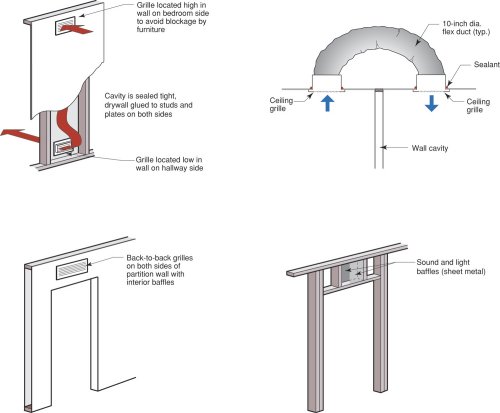
Figures 3a-d - Heating and Cooling – Sealed combustion hot air furnace; SEER 12 air conditioning unit. A single return requires transfer grilles to provide return path and avoid pressurizing bedrooms (see Figures 3a-d).
- Ventilation -
For homes with central forced air distribution system:
Intermittent central-fan-integrated supply, designed to ASHRAE 62.2P rate, with fan cycling control set to operate the central air handler as much as 33% of the time, but not less than 25% of the time, occurring within at least every three hours to provide ventilation air distribution and whole-house averaging of air quality and comfort conditions ($125 to $150). Outside air fraction is designed to keep mixed air temperature at furnace heat exchanger above 50°F, usually not more than a 10% outside air fraction. Optionally include a normally closed motorized damper in the outside air duct (+$50 to $60). See Figures 4, 5 and 6.
In very cold climates ventilation can also be accomplished using a continuous single-point exhaust system, designed to ASHRAE 62.2P rate, pulling from the principal living area ($150).
For homes without central forced air distribution system:
Continuous multi-point exhaust, designed to ASHRAE 62.2P rate, pulling from each bedroom, unless the bedroom has a bathroom then it will pull from the bathroom, and pulling from at least one location in the principal living area. Any combustion appliances must be direct-vent sealed combustion.
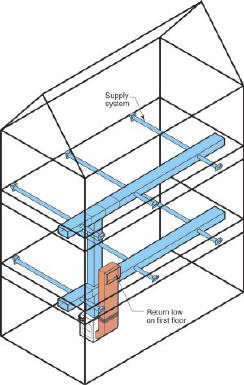
Figure 4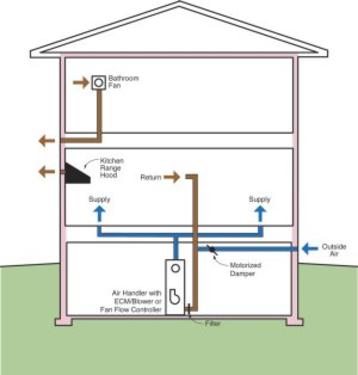
Figure 5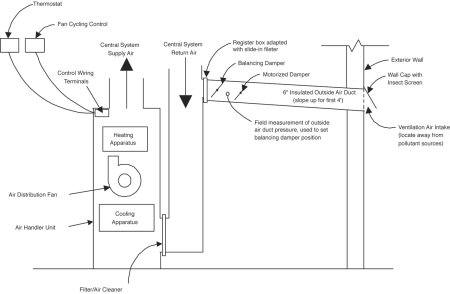
Figure 6 - Basement ConfigurationFor homes without central forced air distribution system:
Continuous multi-point exhaust, designed to ASHRAE 62.2P rate, pulling from each bedroom, unless the bedroom has a bathroom then it will pull from the bathroom, and pulling from at least one location in the principal living area. Any combustion appliances must be power-direct vented sealed combustion. - Supplemental dehumidification - Although high performance homes in this climate rarely require supplemental dehumidification, it is:
… one of three strategies appropriate for conditioned crawlspaces (see Building Science Notes),
… may be desired in homes with full basement foundations, and,
… is strongly recommended when occupants require humidity control (and high-efficiency air filtration) for asthma trigger control.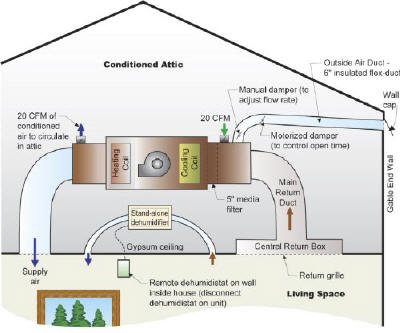 There are a number of different ways to accomplish supplemental dehumidification with varying costs and performance advantages (for a detailed discussion of supplemental dehumidification see Conditioning Air). Described below is one low-cost yet effective approach and one more costly but higher performance/systems-engineered approach:
There are a number of different ways to accomplish supplemental dehumidification with varying costs and performance advantages (for a detailed discussion of supplemental dehumidification see Conditioning Air). Described below is one low-cost yet effective approach and one more costly but higher performance/systems-engineered approach:
1. Ducted stand-alone dehumidifier: This system is a "site-constructed" one consisting of an off-the-shelf standard dehumidifier ducted in the attic and controlled by a dehumidistat located in the living space. This arrangement of individual components has proven to be an effective and economical system for the production home building setting. The installed cost ranges from approximately $350 to $550. The system is comprised of a GE dehumidifier model AHG40FCG1 (dehumidifier located in attic in an insulated enclosure and ducted to living space), Honeywell dehumidistat model H8808C located in living space, and Honeywell switching relay (with transformer) model RA89A 1074. See Figure 6a. The selection of the dehumidifier is based largely on the fact that it has a blower wheel rather than paddle fan that moves air more efficiently in its ducted box configuration.
Note:The following manufacturers make Energy Star-qualified blower wheel stand-alone dehumidifiers:- LG Electronics (all models)
- Haier America (all models)
- Heat Controller (all BHD models use a turbo-impeller with turned blades)
- Or you can check the EPA Energy Star website for dehumidifiers from these manufacturers.
2. Aprilaire 1700: This is a truly engineered, coherently manufactured, supplemental dehumidification system with built-in air filtration, ducted design, and a controls package that integrates central blower cycling for distribution, dehumidification and intermittent introduction of outside air ventilation. The system is also designed for flexibility-it can be connected to the conditioned space directly or to the central air distribution system in a number of configurations. It's also compact and lightweight enough to be set on or hung from most framing. The installed cost for this system is currently about $950 to $1,050. For more information, see: http://www.aprilaire.com
For more information on other high performance supplemental dehumidification systems, see: http://www.thermastor.com - Insect management– In cold climates, insect pressure (termites and carpenter ants) is less pronounced than in warmer climates, but important nonetheless. A three-pronged approach deals with the three things insects need—cover, moisture, and food (wood or paper):
- Reduced cover – Keep plantings 3 feet away from the building perimeter, thin the ground cover (wood mulch or pea stone) to no more than two inches depth for the first 18 inches around the building, and maintain any termite inspection zone on the foundation.
- Control moisture – Maintain slope away from building as shown, carry roof load of water at least three feet away from building, and make sure that irrigation is directed away from the building.
- Treatment – Use an environmentally-appropriate building materials treatment (such as Bora-Care®) for insect-prone, near-grade wood materials.
- Inter-relationship of first three points – Since a builder and a homeowner’s ability to employ or stick to each of the three strategies above will vary, make sure that an inability to fully employ one strategy is compensated for by complete rigor with the others. For example, if for some reason, chemical treatment of soil or building materials is not an option, then complete rigor in moisture control and ground cover is required.
Field Experience Notes
- Selection of rigid insulation – Most builders select rigid insulation based on costs and handling properties. Although the vapor permeability of both EPS and rigid fiberglass insulation can make them particularly well suited to cold climate envelope assemblies, their availability or their user-friendliness (or both) generally make XPS insulation the builder choice. For these reasons, we recommend 1-inch or thicker XPS in most wall assemblies. But remember, the type of sheathing to use is always a question that should be asked in the context of the given cladding and the level of control that can be expected over interior relative humidity via mechanical ventilation. See “Insulations, Sheathings, and Vapor Diffusion Retarders” for more information.
- Joint treatment in rigid insulation– Shiplapped rigid foam insulation has proven to be available in only very limited areas. Mastic works as a water sealant; its long term performance is not known but appears promising. The flexible flashing with polyethylene film is straightforward and creates a natural weatherlap and therefore is the preferred approach.
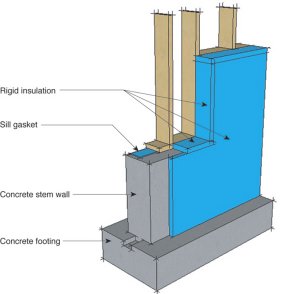
Figure 7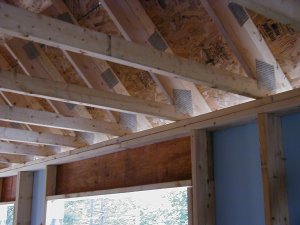
Figure 8 - Flashing details – Since the vinyl siding is a screened wall cladding system, flashing details should be accomplished in the plane of the drainage plane (building paper or house wrap, rigid foam or sheathing), not the cladding. Do not caulk siding and do not rely on the "J"-channel as part of the drainage plane. (In other words, never consider vinyl siding, aluminum siding or any siding, for that matter-as the weather barrier).
- Advanced framing – For a technical resource that may help with resistance to advanced framing methods from local code officials, see the Building Safety Journal article written by Peter Yost of BSC.
- Stepped foundation insulation detail – Maintaining thermal barrier continuity in stepped foundations has proven difficult or easy to neglect. Figure 7 shows how the rigid foam needs to be cut and placed.
- Energy trusses –There are a number of different truss configurations that yield greater depth at the heel, but they vary quite a bit in cost. The truss shown in Figure 8 (sometimes called a “slider” truss) has proven to be among the most cost-competitive. And of course, the pitch of the roof affects just how much insulation you can get at this location, regardless of the type of truss.
Material Compatibility and Substitutions
- Rim joist material – With claddings such as vinyl siding that telegraph dimensional changes in structural materials to which it is attached, rim joist material such as engineered lumber is recommended since it is more dimensionally stable (less shrinkage) than solid sawn material.
- Rim joist insulation- Fiberglass cavity insulation at the rim joist is only acceptable if the exterior sheathing is cavity-warming rigid foam insulation that extends down over the entire rim joist. If non-insulating exterior sheathing is used at the rim joist then one of the following insulation details must be used at the rim joist to manage condensation potential:
- Spray foam insulation in the rim joist cavity
- Fully air-sealed rigid insulation
- Inset rim joist with rigid insulation between the exterior sheathing and the rim joist
- Drainage plane on rigid insulation – An alternative to flashing, shiplapping, or sealing the XPS insulation for continuity of the drainage plane is to apply a housewrap to the outside of the insulation. The housewrap then becomes the continuous drainage plane. It is also possible to install the housewrap under the XPS insulation (this is a more common commercial wall system approach).
- Interior latex paint - The substitution of low permeability interior finishes (vinyl wall paper, oil-based paints) for latex paint should be considered in the context of severely limiting or eliminating any drying potential that the wall assembly has to the interior. These interior treatments are not recommended.
- Cavity insulation materials – Acceptable cavity insulation includes any that have a relatively high vapor permeability—cellulose, fiberglass, foam (as long as air sealing is accomplished by a separate component or system when cellulose or fiberglass is used). User discretion can be based on properties other than building science.
- Gypsum wallboard –Areas of potentially high moisture, such as bathrooms, basements, kitchens, are excellent candidates for non-paper faced wallboard systems (e.g. James Hardie’s Hardibacker®, GP’s DensArmor®, USG’s Fiberock®). In addition, paper-faced gypsum board should never be used as interior sheathing or backer for tub or shower surrounds where ceramic tile or marble (any material with joints or grout lines) is used as the finish.
- Cast concrete foundation walls – If block is used instead of cast concrete for foundation walls, the bond beam becomes essential to maintain air barrier continuity at the top of the block wall.
- L-channel detail on cladding at base of exterior wall – Any stop can be used at the bottom, exposed edge of the rigid insulation to prevent insect and rodent intrusion, as long as it does not interfere with the foam’s function as the drainage plane.

